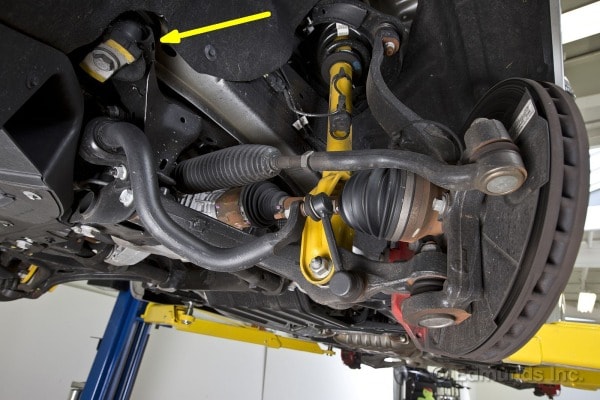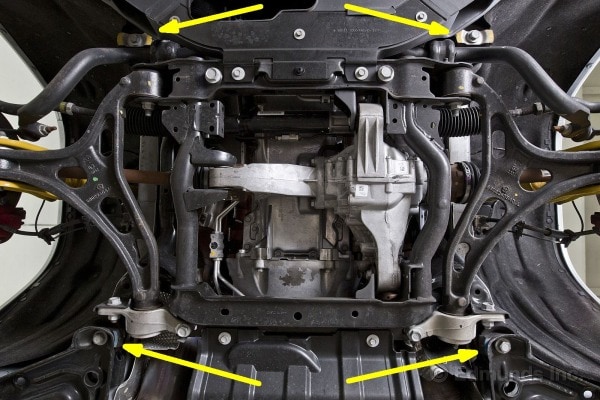Our 2012 Jeep Grand Cherokee SRT8 is destined for a new name in 2014 because, like the Dodge Viper, it's being reallocated to the new SRT brand. Henceforth it will be known as the 2014 Grand Cherokee SRT, though the Jeep badge may remain on the vehicle's sheet metal someplace.
But will anything really be different? Perhaps the most significant and welcome change is a new eight-speed automatic transmission, up from the current five-cog autobox that ours has. This gearbox enables a new launch mode, and the extra gears make it possible to get more creative with the shift schedule, including a new "Eco" mode. But fuel economy and shift smoothness should improve outright even when you're not in Eco mode by the sheer number of newly available gears.
They say the tow rating will rise from 5,000 to 7,200 pounds, which for me is worrisome without changes to the suspension. But this is already one stiff machine as it is, and at the same time the tail end of our 2012 example sagged a bit under the tongue weight of some towed EVs.
In deference to the new tow rating I expect a thorough suspension retune, but simply making the rear suspension stiffer to handle the extra tongue weight may not work on its own. The towing issue may prompt detail changes we can't yet guess, but based on my knowledge of the 2014 specs, the layout and design of the suspension itself will remain much the same as our 2012 Jeep Grand Cherokee SRT8 long-term test vehicle.
This seems like as good a reason as any to hoist our 2012 Jeep Grand Cherokee SRT8 up on our Rotary lift and poke around.

The front end rides on a double-wishbone front suspension, and from here we see that the upper wishbone is of the high-mount variety.

Bright yellow Bilstein coil-over shocks shoulder the load.

Ferrous Bueller? All of the major front suspension bits are made of steel or cast iron.
Meanwhile, the front subframe that carries it all is bolted to the unibody in four places through bushings like the one indicated by the arrow.

From here we can see all four of the subframe mounting bushings. The steering rack, front stabilizer bar and front differential all mount to the subframe as well.

By now you've probably noticed that the Jeep Grand Cherokee's steering system acts ahead of the front axle centerline. This isn't always possible in vehicles that have all-wheel drive. It usually comes down to how the engine is mounted. Front steer is possible if the motor sits longitudinally, as it does here, but rear steer is usually necessary if the engine and transmission sit crossways, as they do in most front-drive vehicles and their AWD variants.
Beyond that, something isn't quite right in the picture, and it isn't that arrow. Can you spot it?

The Grand Cherokee's coil-over spring and shock connect to the lower control arm at a point that's good for a motion ratio in the neighborhood of 0.7-to-1, and the slightly outboard position of the stabilizer bar drop link's connection point is good for 0.8-to-1 or thereabouts.
The problem I alluded to in the last frame is more clearly visible here. The jam nut for the steering tie rod end is loose. It should be tight up against it so the toe-in setting and steering wheel alignment will stay put. In this case the steering was still perfectly centered, suggesting no inadvertent movement, so I tightened the jam nut and moved on.

The lower wishbone is more of a T-shape than we sometimes see, but don't get too upset if Jeep refers to it as an A-arm in the literature because they amount to the same thing.

The upper wishbone is made of stamped steel, with a stiffening element welded in to box the structure for additional strength.

The Bilstein monotube shocks are electronically adjustable. The adjustments are continuously regulated by a computer, hence the name Adaptive Damping System or ADS.

It's hard to miss the massive Brembo six-piston front brake calipers. They're much bigger than the ones mounted to the front end of the 2013 SRT Viper, but then the 2012 Jeep Grand Cherokee SRT8 weighs a ton more. Well, not exactly a ton. More like 1,896 pounds on our scales.

The pads are huge, and the open-window caliper design makes them easy to change. But the extreme size of the opening that goes with six pistons would allow the caliper to flex too much as the brakes were applied if this bridge bolt hadn't been fitted. You must remove it, of course, before a pad swap.

Now you know why I call this feature a Suspension Walkaround.
Meanwhile, a slot in the lower bumper fascia ducts and accelerates air in behind the brakes to help dissipate heat. Seems set to cool the stabilizer bar as well.

Not much to see here, but the spec sheet says this is a multilink rear suspension.

There's an aluminum lower wishbone (green) and a rear-mounted toe link (yellow.) But what's going on up at the top?

Here there are two distinct links, arrayed in an A-shape to approximate an upper control arm. If this were Subaru it would go ahead and erroneously call this double-wishbone suspension, but Jeep knows better. The forward one (yellow) angles more toward the front and is thereby known as a tension link, and the aft-located one (green) angles nearly straight in, so Jeep deems it a camber link.

The rear coil spring nestles up against the bottom of the Jeep's unibody, but the thing to notice here is the eccentric camber adjuster fitted to the inner pivot of the camber link.

While the two upper links and the toe link are mainly there to keep the wheel oriented properly, the massive cast aluminum lower wishbone does almost all of the heavy lifting. It carries the load of the spring, shock and stabilizer bar, and it shoulders the lion's share of cornering forces and the fore-aft component of harsh road impacts, such as pothole strikes.

Behold the lower wishbone, which in this case really is A-shaped. I'll admit the font is a bit tortured, but still.
This view also shows how the toe link keeps the wheels and tires pointed straight. It's also easy to imagine how an engineer might fit four-wheel steering by giving this link the ability to move.

Just like we saw up front, the rear suspension members attach to a steel subframe, which in turn bolts to the unibody through four bushings.

The shock connects to the lower wishbone at what looks like a 0.70-to-1 motion ratio, and the stabilizer bar sits just inboard of that at something closer to 0.55-to1. But we mustn't forget the spring, which nestles into a pocket on the far leg of the arm at something in the neighborhood of 0.60-to-1 or so.

To the surprise of no one, Bilstein ADS electronically controlled shocks like those we saw up front keep a damper on the action back here, too.

Since the bulk of any car's braking happens up front, mere four-piston Brembo calipers are sufficient to do the job out back.

A 5,261-pound hot-rod SUV on 295/45ZR20 run-flat tires isn't going to get away with lightweight wheel and tire assemblies. Our stock summer Pirelli P Zero rubber and the 10-inch forged aluminum wheels they come on weigh 79.2 pounds apiece.
Among the new goods announced for the 2014 Grand Cherokee SRT are new wheels. Let's hope they're lighter. And while we're at it, a bit of lightening of the suspension bits wouldn't hurt either, especially if they're upping the tow rating by 44 percent and need to stiffen the rear end accordingly.
I for one would like to see rear load leveling instead of stiffer rear springs, but that seems unlikely because the spec sheets say they're continuing on with Bilstein ADS dampers and rear coil springs. We'll have to wait for some months to see what they cook up.


